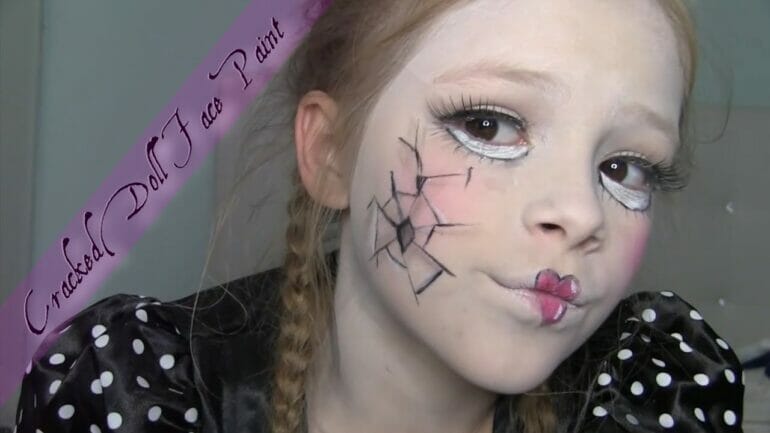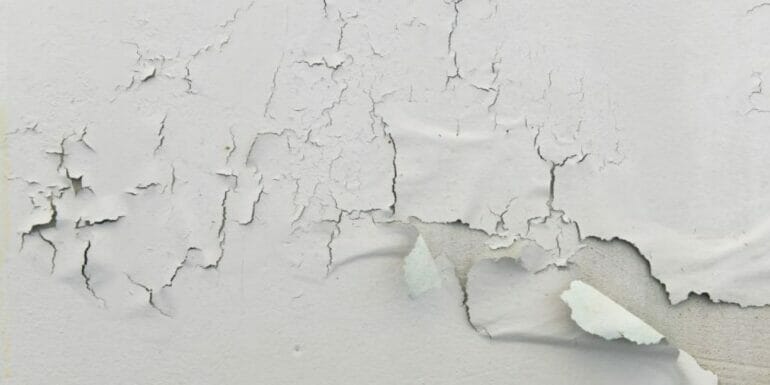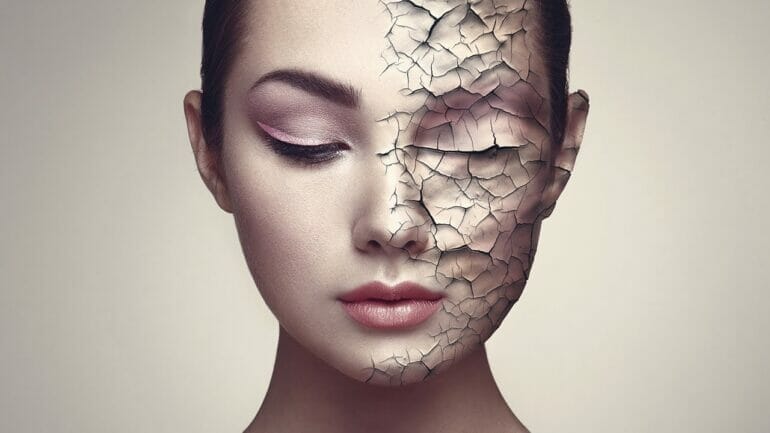If you’re experiencing cracking in your face paint, it can be frustrating and affect the overall look of your makeup. Cracking can occur due to various reasons, such as dry skin, improper application techniques, or using low-quality products. To prevent cracking, ensure your skin is well moisturized before applying face paint and use a primer to create a smooth base. Additionally, use high-quality face paints and apply thin layers, allowing each layer to dry before adding more. Properly sealing your face paint with a setting spray can also help to prevent cracking.

Common Mistakes Leading to Cracked Face Paint and How to Avoid Them
Face painting is a popular activity at parties, festivals, and events. It allows people to express their creativity and transform their appearance. However, there are common mistakes that can lead to cracked face paint, ruining the overall look and causing discomfort for the wearer. In this section, we will discuss these mistakes and provide tips on how to avoid them.
1. Applying too thick of a layer: One of the most common mistakes in face painting is applying too much paint at once. This can cause the paint to crack when it dries, especially if the layer is thick. To avoid this, make sure to apply thin layers of paint and allow each layer to dry before adding more. This will help the paint adhere to the skin properly and prevent cracking.
2. Using low-quality face paint: Another mistake that can lead to cracked face paint is using low-quality products. These paints may not have the same consistency or durability as professional-grade ones. Investing in high-quality face paints will ensure better results and reduce the likelihood of cracking. Look for paints specifically made for face painting and check for reviews and recommendations before purchasing.
3. Not preparing the skin properly: Preparing the skin before applying face paint is essential for a smooth and crack-free finish. Cleanse the skin thoroughly to remove any dirt, oil, or moisturizer that may interfere with the paint’s adherence. Applying a thin layer of primer or a water-based moisturizer can also help create a smooth canvas for the paint.
4. Using the wrong tools: Using the wrong tools can contribute to cracked face paint. Avoid using brushes with stiff bristles or sponges that are too dry or rough. Opt for soft brushes and dampen your sponge slightly before applying the paint. These tools will help distribute the paint evenly without causing friction or dragging, which can lead to cracking.
5. Overworking the design: Overworking a face paint design can cause the paint to crack and chip. Avoid going over the same area multiple times or excessively blending the colors. The more you manipulate the paint, the higher the chances of it cracking. Take your time and work gently to achieve the desired design without compromising the integrity of the paint.
6. Not allowing enough drying time: Allowing sufficient drying time between layers and designs is crucial to avoid cracked face paint. Rushing the process can lead to the layers not fully adhering to each other, resulting in cracking. Ensure each layer is completely dry before moving on to the next and avoid touching or rubbing the painted areas until they are fully dry.
7. Skipping the setting powder: Applying a setting powder at the end of the face painting process can help prevent the paint from cracking and smudging. The setting powder absorbs any excess moisture and sets the paint in place, increasing its longevity. Dust a thin layer of setting powder over the painted areas using a clean brush or a powder puff for a professional and long-lasting finish.
In summary, cracked face paint can be avoided by following these tips: applying thin layers of paint, using high-quality face paints, preparing the skin properly, using the right tools, avoiding overworking the design, allowing sufficient drying time, and using a setting powder. By avoiding these common mistakes, you can ensure a beautiful and long-lasting face paint design.

Understanding the Causes of Cracking Face Paint and Solutions
Face painting is a popular activity enjoyed by people of all ages, from children at birthday parties to adults at festivals and events. It allows individuals to transform themselves into whimsical characters or showcase their creative side. However, nothing is more frustrating than spending time and effort on a face paint design, only to have it crack and ruin the overall look. In this section, we will explore the causes of cracking face paint and provide some effective solutions to prevent this issue.
Causes of Cracking Face Paint
1. Insufficient Moisture: One of the primary reasons for cracking face paint is the lack of moisture. When the skin is dry, it becomes less elastic, making it prone to cracking. Additionally, if the face paint itself is not adequately moisturized, it can dry out and crack when applied to the skin.
2. Low-Quality Face Paint: Using low-quality face paint can contribute to cracking. Inferior products may not have the right consistency or ingredients necessary to provide a smooth and flexible finish. These products can dry out quickly and result in cracking.
3. Incorrect Application Technique: Applying face paint too thinly or unevenly can lead to cracking. When the paint layer is too thin, it is more prone to drying out and cracking. Similarly, if the paint is applied unevenly, certain areas may not have enough coverage, causing cracks to form.
4. Environmental Factors: Environmental factors, such as excessive heat or cold, can affect the durability of face paint. Extreme temperatures can cause the paint to expand or contract, leading to cracks. Additionally, exposure to direct sunlight can dry out the paint and make it more susceptible to cracking.
Solutions to Prevent Cracking
1. Proper Skin Preparation: Before applying face paint, ensure that the skin is well moisturized. Use a gentle moisturizer that is suitable for the face to keep the skin hydrated and supple. This will help prevent dryness and cracking.
2. Choose High-Quality Face Paint: Invest in good quality face paints that are specifically formulated for skin use. These paints are typically made with high-grade ingredients that provide better coverage and flexibility. They are less likely to dry out and crack compared to cheaper alternatives.
3. Apply Face Paint in Layers: Instead of applying a thick layer of face paint at once, opt for thin layers. Allow each layer to dry before applying the next one. This technique helps to build up the color and ensures that the paint adheres properly to the skin without cracking.
4. Avoid Extreme Temperatures: Try to avoid exposing your face paint to extreme temperatures. If you are outdoors on a hot day, consider providing shade or using an umbrella to shield yourself from direct sunlight. Similarly, during colder weather, protect your face from freezing temperatures that can cause the paint to crack.
5. Seal the Face Paint: After applying the face paint, consider using a setting spray or powder to seal the design. This extra step helps to lock in the moisture and prevents the paint from drying out and cracking. It also helps to prolong the longevity of the face paint.
In summary, cracking face paint can be a disappointing experience, but with proper understanding and preventive measures, it can be avoided. Ensuring sufficient moisture, using high-quality face paint, applying it correctly, and considering environmental factors are all essential in maintaining a flawless face paint design. By implementing these solutions, you can enjoy vibrant and crack-free face paint for any occasion.

Moisturizing Techniques for Crack-Free Face Paint
Face painting can be a fun and creative activity, whether it’s for a costume party, a school event, or a special occasion. However, one of the challenges of face painting is maintaining the integrity of the paint on the skin without it cracking or flaking. To avoid this issue and ensure your face paint lasts longer, it is important to properly moisturize the skin before application. In this section, we will discuss some effective moisturizing techniques that can help you achieve crack-free face paint.
1. Cleanse and Exfoliate
Before moisturizing, it is essential to cleanse and exfoliate the skin to remove any dirt, oil, or dead skin cells that may interfere with the absorption of moisturizers. Use a gentle cleanser suitable for your skin type and rinse thoroughly. Then, exfoliate the skin using a mild scrub to slough off any dry or flaky patches, creating a smooth canvas for face paint application.
2. Hydrate with a Facial Mist
Using a facial mist is a great way to hydrate the skin and prepare it for face paint. Look for a mist that contains hydrating ingredients like glycerin or hyaluronic acid. Simply spritz the mist onto the face, keeping the eyes closed, and allow it to absorb into the skin. This will help to boost moisture levels and create a barrier between the skin and the face paint.
3. Apply a Moisturizer
After cleansing and hydrating the skin, it’s time to apply a moisturizer. Choose a lightweight, non-greasy moisturizer that is formulated for your specific skin type. Massage a small amount of moisturizer onto the face and neck, focusing on any dry areas. Allow the moisturizer to fully absorb into the skin before proceeding with face paint application.
4. Use a Primer
Applying a primer before face paint can help create a smooth surface and improve the longevity of the paint. Look for a primer that is designed for face paint or choose a silicone-based primer that will fill in fine lines and pores. Apply a thin layer of primer to the entire face, blending it in with your fingertips or a makeup sponge.
5. Avoid Oil-Based Face Paint
When selecting face paint, opt for water-based or cream-based formulas as they tend to be more moisturizing and less likely to crack. Oil-based face paints can be drying and may cause the paint to crack or flake. Look for face paints that are labeled as “moisturizing” or “hydrating” to ensure a crack-free finish.
6. Set the Face Paint with Setting Spray
To further enhance the longevity of your face paint, consider setting it with a setting spray. Setting sprays help to lock in the pigments and create a protective barrier on the skin. Choose a setting spray that is suitable for face paint and spritz it lightly over the painted areas. Allow the setting spray to dry before touching or rubbing the face.
7. Touch-Ups and Maintenance
Even with proper moisturizing techniques, face paint can still experience wear and tear, especially if the face is frequently touched or exposed to moisture. Carry a small touch-up kit with you that includes a damp sponge or brush and a small container of face paint. Use these tools to fix any cracks or smudges that may occur throughout the day.
In summary, moisturizing techniques play a crucial role in achieving crack-free face paint. By cleansing, exfoliating, hydrating, and properly moisturizing the skin, you can create a smooth canvas for face paint application. Using a primer, selecting the right face paint formula, and setting it with a setting spray will further enhance the longevity of the paint. Remember to carry touch-up tools for maintenance throughout the day. With these techniques, you can enjoy vibrant and crack-free face paint that lasts all day long.
Expert Advice: Troubleshooting Cracked Face Paint Issues
Face painting is a popular activity at parties, fairs, and festivals. It allows people to transform into their favorite characters or creatures, and adds an element of fun and excitement to any event. However, one common issue that face painters may encounter is cracked face paint. Cracked face paint not only looks unappealing, but it can also be uncomfortable for the person wearing it. In this section, we will discuss some expert advice and troubleshooting tips to help you resolve cracked face paint issues.
1. Use High-Quality Face Paint
One of the main reasons why face paint cracks is because of the quality of the product used. It is important to invest in high-quality face paint that is specifically designed for use on the face and body. Look for brands that are known for their durability and long-lasting formula. These face paints are often made with ingredients that are gentle on the skin and less likely to crack or flake.
2. Prepare the Skin Properly
Preparation is key to preventing cracked face paint. Before applying the face paint, make sure the skin is clean and dry. Remove any oil or moisturizer from the face using a gentle cleanser. Apply a thin layer of face primer or a water-based moisturizer to create a smooth surface for the paint to adhere to. This will help the face paint to last longer and reduce the chances of cracking.
3. Apply Thin Layers
When applying face paint, it is important to use thin layers instead of thick ones. Thick layers of face paint are more prone to cracking and flaking. Use a sponge or brush to apply the face paint in smooth, even strokes. Allow each layer to dry completely before applying the next one. This will ensure that the paint adheres properly and reduces the risk of cracking.
4. Avoid Overworking the Paint
Overworking the paint can also lead to cracking. Once you have applied the face paint, avoid going over the area multiple times or rubbing the paint excessively. This can cause the paint to become dry and brittle, resulting in cracks. Instead, apply the paint with gentle strokes and avoid excessive touching or rubbing.
5. Set the Face Paint
To help prevent cracking, it is important to set the face paint once it has dried. Use a setting powder or a makeup setting spray to lock the paint in place. This will create a protective barrier and help the face paint to last longer without cracking. Gently brush the setting powder over the painted area or mist the setting spray evenly over the face to set the paint.
6. Keep the Skin Hydrated
Dry skin is more prone to cracking, so it is important to keep the skin hydrated before and after applying face paint. Drink plenty of water to keep the skin hydrated from within. Additionally, you can use a water-based moisturizer or a face mist to keep the skin moisturized throughout the day. This will help the face paint to stay intact and reduce the chances of cracking.
7. Remove the Face Paint Properly
After the event or party, it is essential to remove the face paint properly to avoid any skin irritation or damage. Use a gentle cleanser or baby wipes to remove the paint. Avoid scrubbing or rubbing the face vigorously, as this can cause irritation and dryness. Once the face paint is removed, apply a moisturizer to soothe and hydrate the skin.
In summary, cracked face paint can be a common issue, but with the right techniques and precautions, it can be easily resolved. Using high-quality face paint, preparing the skin properly, applying thin layers, avoiding overworking the paint, setting the face paint, keeping the skin hydrated, and removing the paint properly are all important steps to prevent cracked face paint. Remember, practice makes perfect, so don’t be discouraged if you encounter some cracks along the way. With time and experience, you will be able to create flawless face paint designs that last without any issues.
FAQs
Why is my face paint cracking?
Face paint can crack due to several reasons. It could be because the paint was applied too thickly, the skin was not properly prepared, or the paint is of low quality. Additionally, movement of facial muscles, excessive sweating, or dry skin can also cause the paint to crack.
Conclusion:
In conclusion, experiencing cracked face paint can be frustrating and disappointing, but there are a few potential reasons why this might occur. Firstly, inadequate preparation and improper application of a base layer can lead to cracking. It’s important to thoroughly cleanse and moisturize the skin before applying face paint. Additionally, using low-quality or expired face paint products can cause cracking. Opting for high-quality, professional-grade face paints can help prevent this issue. Lastly, environmental factors such as cold temperatures or excessive dryness can contribute to the cracking of face paint. Taking care to protect your face from extreme weather conditions can help maintain the longevity and integrity of your face paint.
